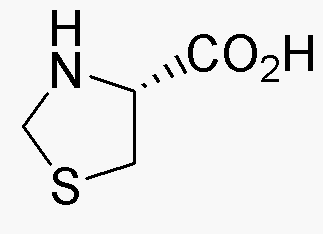L-Thiaproline is widely utilized in research focused on:
- Pharmaceutical Development: This compound serves as a building block in the synthesis of various pharmaceuticals, particularly in creating drugs that target neurological disorders.
- Protein Engineering: L-Thiaproline is used to modify proteins, enhancing their stability and functionality. This is crucial in biotechnological applications where tailored proteins are needed.
- Peptide Synthesis: It plays a significant role in peptide synthesis, allowing researchers to create peptides with unique properties for therapeutic applications.
- Research on Amino Acid Analogues: As an amino acid analogue, it helps in studying metabolic pathways and enzyme functions, providing insights into various biological processes.
- Cosmetic Formulations: L-Thiaproline is incorporated into cosmetic products for its potential skin benefits, such as improving skin elasticity and reducing signs of aging.
General Information
Properties
Safety and Regulations
Applications
L-Thiaproline is widely utilized in research focused on:
- Pharmaceutical Development: This compound serves as a building block in the synthesis of various pharmaceuticals, particularly in creating drugs that target neurological disorders.
- Protein Engineering: L-Thiaproline is used to modify proteins, enhancing their stability and functionality. This is crucial in biotechnological applications where tailored proteins are needed.
- Peptide Synthesis: It plays a significant role in peptide synthesis, allowing researchers to create peptides with unique properties for therapeutic applications.
- Research on Amino Acid Analogues: As an amino acid analogue, it helps in studying metabolic pathways and enzyme functions, providing insights into various biological processes.
- Cosmetic Formulations: L-Thiaproline is incorporated into cosmetic products for its potential skin benefits, such as improving skin elasticity and reducing signs of aging.
Documents
Safety Data Sheets (SDS)
The SDS provides comprehensive safety information on handling, storage, and disposal of the product.
Product Specification (PS)
The PS provides a comprehensive breakdown of the product’s properties, including chemical composition, physical state, purity, and storage requirements. It also details acceptable quality ranges and the product's intended applications.
Certificates of Analysis (COA)
Search for Certificates of Analysis (COA) by entering the products Lot Number. Lot and Batch Numbers can be found on a product’s label following the words ‘Lot’ or ‘Batch’.
Numéro de catalogue
Numéro de lot/série
Certificates Of Origin (COO)
This COO confirms the country where the product was manufactured, and also details the materials and components used in it and whether it is derived from natural, synthetic, or other specific sources. This certificate may be required for customs, trade, and regulatory compliance.
Numéro de catalogue
Numéro de lot/série
Safety Data Sheets (SDS)
The SDS provides comprehensive safety information on handling, storage, and disposal of the product.
DownloadProduct Specification (PS)
The PS provides a comprehensive breakdown of the product’s properties, including chemical composition, physical state, purity, and storage requirements. It also details acceptable quality ranges and the product's intended applications.
DownloadCertificates of Analysis (COA)
Search for Certificates of Analysis (COA) by entering the products Lot Number. Lot and Batch Numbers can be found on a product’s label following the words ‘Lot’ or ‘Batch’.
Numéro de catalogue
Numéro de lot/série
Certificates Of Origin (COO)
This COO confirms the country where the product was manufactured, and also details the materials and components used in it and whether it is derived from natural, synthetic, or other specific sources. This certificate may be required for customs, trade, and regulatory compliance.


